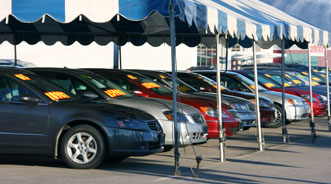Beige Book: Dealers’ Used Sales Healthy

In examining the overall health of dealerships across the country, the Federal Reserve observed in its latest Beige Book report a rather robust auto market, both on the used- and new-vehicle fronts.
Used-sales have been healthy, while the new-vehicle market in the majority of areas was either stable or showed improvement, the Fed noted.
“Most districts reported that sales of new vehicles held steady or rose during the reporting period. Sales of used vehicles were strong as well. Inventories remained tight, particularly for popular vehicles,” officials noted.
“Used-car prices rose, reflective of solid demand and lean inventories. Respondents’ outlooks were for slight growth in sales through year-end,” they added.
Breaking it down, the report offered specific analysis on dealerships in each of the 12 Federal Reserve districts, beginning with Boston.
Boston
While not offering any auto-specific details, the Fed noted that the overall retail market was largely “mixed” last month and in the beginning of this month.
“Year-over-year same-store sales range from decreases in the low single digits to increases in the mid-single digits,” officials pointed out. “Contacts note that consumers are increasingly responsive to ‘getting a good deal;’ those with increases attribute the uptick in sales to strong marketing, promotional activity, or stocking ‘the right mix of products’ at discounted prices,” the Fed continued.
New York
Looking specifically at the upstate New York region of the Second District, the Fed noted that new-car sales were pretty solid in August and September, despite the unfavorable impact on year-over-year comparison from CARS.
“Sales and prices of used cars have reportedly been buoyed somewhat by strong demand and lean inventories of new vehicles. Auto dealers report continued improvement in credit conditions,” officials shared.
Philadelphia
Moving over to the Third District, the Fed said September new-car sales were “steady” and showed modest year-over-year gains. It was predicted by dealers that sales will show gradual gains the remainder of 2010 and beyond.
“Inventories were generally described as light, and supplies of popular models were said to be particularly lean,” officials stated. “Dealers expect sales to improve slowly during the rest of this year and into next year.”
Cleveland
While the August new-vehicle market in the Fourth District was “decent,” sales dipped from the summer apex, the Fed said. Moreover, CARS caused a negative year-over-year comparison during the month.
As for the rest of the year, dealers aren’t making very large projections. They believe there will be “modest sales increases at best.”
With regards to new-vehicle inventory, it is still fairly thin, “especially for popular models.”
On the used side, supply is limited and prices are heavy, but there has been an uptick in used-vehicle sales from the last Beige Book report.
“The number of financing options is growing across the district, and pricing is competitive,” the Fed pointed out. “Still, credit standards are tight, and potential buyers often find themselves unqualified for the vehicle they want to purchase. The incremental hiring at auto stores that began in mid-summer has tapered off.”
Richmond
Next up was the Fifth District. The Fed said there has been a major decline for big-ticket sales, especially in the auto sector.
“Indeed, big-ticket sales, particularly among automobile dealers, fell sharply in our most recent survey,” officials noted. “One exception was a car dealer in West Virginia, who reported that sales rose modestly.”
Atlanta
Continuing on to the Sixth District, dealers showed gain as compared to 2009. Specifically, the Fed noted: “District automobile dealers indicated that vehicle sales were ahead of year-ago levels.”
Chicago
In the Seventh District, dealerships had fairly stable sales performances, in the midst of decrease incentives and credit access that was still “slowly” making strides.
“The pace of consumer spending was little changed from the previous reporting period. Contacts indicated that consumers were slowly regaining confidence, although they remain very price-conscious,” the Fed said of the overall retail market.
“As such, promotions and sales persisted as the primary driver of traffic in stores and showrooms. Retail sales excluding autos in September were nearly on par with the August sales pace,” officials continued.
They added: “Auto sales held steady, even as fewer incentives were offered and access to credit continued to slowly improve.”
St. Louis
Next on the list was St. Louis. In the Eighth District, new-vehicle sales dipped on a year-over-year basis and used-vehicle sales improved, the Fed stated.
Minneapolis
Moving over to the Ninth District, the Fed said the overall retail market showed consumer spending climb “moderately.” As far as auto-specific results, the Fed discussed how dealers in Montana are faring.
“September car sales in Montana were mixed, according to a representative of an auto dealers association,” officials pointed out.
Kansas City
Continuing along, the vehicle market in the 10th District was softer compared to where it was in the previous Beige Book report. However, it showed year-over-year gains.
“Automobile sales weakened considerably from the last reporting period but remained slightly above year-ago levels,” the Fed shared. “Auto inventories continued to decline and dealers expressed satisfaction with current inventory levels.”
Dallas
For the 11th District, the Fed indicated that there was stability in the vehicle market, when seasonal adjustments were made. As far as inventory, officials said it is somewhat “tight.” There is particularly limited inventory of large SUVs, officials stated.
The Fed added: “Used-car prices have risen, reflecting elevated demand and short supply. Expectations are for continued slow growth in sales.”
San Francisco
Finally, the Fed discussed the 12th District. Officials said there were modest gains here.
“Sales of new domestic and imported automobiles improved a bit, with dealers citing replacement of broken-down or leased vehicles as key motivating factors for purchases,” they noted.
WASHINGTON, D.C. –
Subscribe to receive our daily e-newsletter and never miss the latest industry news, trends, and insights across the used-car and remarketing space.


